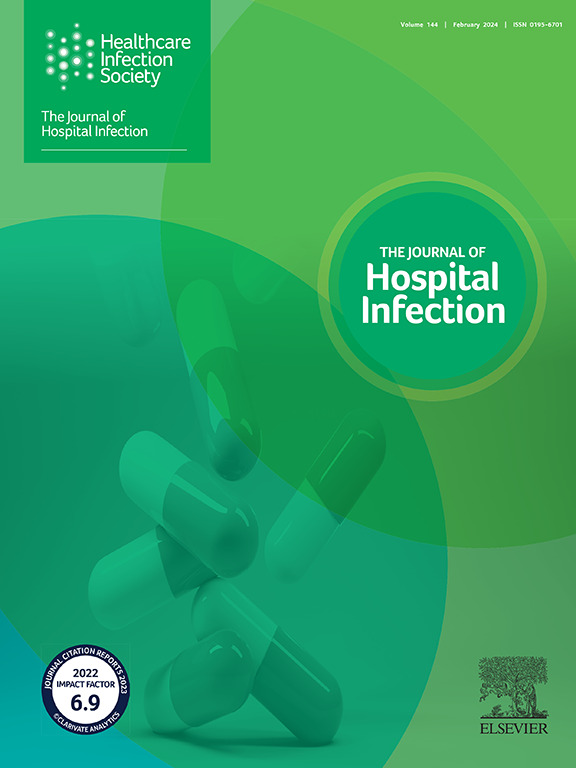Impact of COVID-19 pandemic on the implementation of transmission-based precautions
IF 3.9
3区 医学
Q1 INFECTIOUS DISEASES
引用次数: 0
Abstract
Background
Multidrug-resistant organisms and hospital-acquired infections threaten patient safety. Transmission-based precautions (TBPs) are critical infection prevention and control (IPC) measures but resource intensive. The COVID-19 pandemic disrupted routine IPC practices due to resource diversion for pandemic response, straining systems and compromising TBPs for pathogens of interest (POIs).
Aim
To investigate the impact of the COVID-19 pandemic on the implementation of pathogen-specific TBPs in five Singapore acute hospitals before and during the COVID-19 pandemic from August 2020 to August 2021.
Methods
The primary outcome measure was the proportion of patients on appropriate pathogen-specific TBPs. The variables between the two cycles were compared to assess the impact of COVID-19 on the implementation of pathogen-specific IPC measures.
Findings
A total of 8601 patient records were reviewed (4132 in Cycle 1 and 4469 in Cycle 2). Appropriate TBP implementation decreased by 39% during Cycle 2 compared to Cycle 1 (odds ratio (OR): 0.61; 95% confidence interval (CI): 0.50–0.73; P < 0.01). Staff unawareness of POIs emerged as the most common factor contributing to inappropriate TBP placement across both cycles. Notably, patients with meticillin-resistant Staphylococcus aureus only experienced a significant decrease in appropriate TBP during Cycle 2 (OR: 0.56; 95% CI: 0.44–0.71; P < 0.01). Interestingly, hospitals with higher pre-pandemic TBP adherence rates maintained better compliance during the pandemic.
Conclusion
The COVID-19 pandemic adversely affected the implementation of appropriate TBPs in Singapore acute care hospitals. This study highlights the need for proactive appropriate TBP maintainance during public health emergencies.
COVID-19大流行对实施基于传播的预防措施的影响。
背景:耐多药生物(mdro)和医院获得性感染(HAIs)威胁着患者的安全。基于传播的预防措施是重要的感染预防和控制措施,但需要大量资源。COVID-19大流行扰乱了IPC的常规做法,原因是资源被用于大流行应对、系统紧张以及目标病原体tbp受损。本研究分析了2020年8月至2021年8月2019冠状病毒病大流行之前和期间新加坡五家急性医院的IPC做法。目的:探讨2019冠状病毒病疫情对实施病原体特异性TBP的影响。方法:主要结局指标是采取适当病原体特异性传播预防措施(TBP)的患者比例。我们比较了两个周期之间的变量,以评估COVID-19对实施病原体特异性IPC措施的影响。结果:共审查了8601例患者记录(第1周期4132例,第2周期4469例)。与第1周期相比,第2周期适当的TBP实施减少了39% (OR, 0.61;95% ci, 0.50-0.73;结论:2019冠状病毒病大流行对新加坡急症医院实施适当的tbp产生不利影响。这项研究强调,有必要在突发公共卫生事件期间采取主动行动,维持适当的TBPs。
本文章由计算机程序翻译,如有差异,请以英文原文为准。
求助全文
约1分钟内获得全文
求助全文
来源期刊

Journal of Hospital Infection
医学-传染病学
CiteScore
12.70
自引率
5.80%
发文量
271
审稿时长
19 days
期刊介绍:
The Journal of Hospital Infection is the editorially independent scientific publication of the Healthcare Infection Society. The aim of the Journal is to publish high quality research and information relating to infection prevention and control that is relevant to an international audience.
The Journal welcomes submissions that relate to all aspects of infection prevention and control in healthcare settings. This includes submissions that:
provide new insight into the epidemiology, surveillance, or prevention and control of healthcare-associated infections and antimicrobial resistance in healthcare settings;
provide new insight into cleaning, disinfection and decontamination;
provide new insight into the design of healthcare premises;
describe novel aspects of outbreaks of infection;
throw light on techniques for effective antimicrobial stewardship;
describe novel techniques (laboratory-based or point of care) for the detection of infection or antimicrobial resistance in the healthcare setting, particularly if these can be used to facilitate infection prevention and control;
improve understanding of the motivations of safe healthcare behaviour, or describe techniques for achieving behavioural and cultural change;
improve understanding of the use of IT systems in infection surveillance and prevention and control.
 求助内容:
求助内容: 应助结果提醒方式:
应助结果提醒方式:


